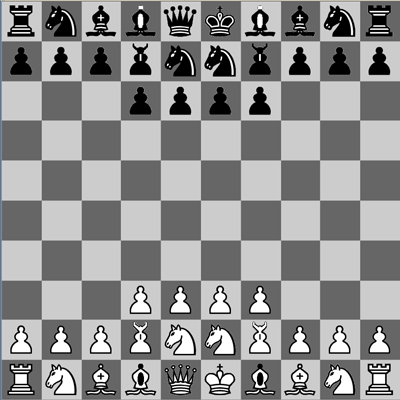SUCCHESS
Succhess stands for Super Creative Chess. Created and implemented by Djafer Medjahed, from Moscow Russia. Succhess was first released on July 3rd 2008. The new game was developed as an alternative to Gothic chess, Grand Chess, or Omega Chess. Contrary to these variants, the new pieces introduced in Succhess remain simple enough for the human brain to digest them easily. At the same time, the newly introduced pieces allow positional play to further develop as well as some new type of tactical and strategical play. The purpose of Succhess is to favor creativity over experience. Further information can be found here : http://sagiastar.blogspot.com/Setup
The board is an array of 10x10 squares just as classical chess is 8x8. The starting position is shown below : White:
White:
Pawn a2 b2 c2 i2 j2 h2 d3 e3 f3 g3; Hero d2 g2; Spy d1 g1; Knight b1 i1 e2 f2; Bishop c1 h1; Rook a1 j1; Queen e1; King f1;
Black:
Pawn a9 b9 c9 i9 j9 h9 d8 e8 f8 g8; Knight b10 i10 e9 f9; Hero d9 g9; Spy d10 g10; Bishop c10 h10; Rook a10 j10; Queen e10; King f10;
Pieces
New single pieces : The Hero, The SpyNew Group pieces : The Horde, The Phalanx
All the classical chess pieces are kept : pawn, bishop, knight, rook queen, king. Pawns and knights have new additional moves. All the new properties and pieces are described in rules below.
Rules
- The board is 10x10
- The pawns can advance of one, two or three squares if located on the 2nd rank (9th rank for black). If they are located on the 3rd rank (8th rank), they can advance of one or two squares.
- En-passant applies for two or three square moves of pawns.
If the pawn is located on the 2nd rank and moves to the 5th rank, not only the enemy pawn on the neighboring 5th rank can capture, but also the one on the neighboring 4th rank.
- If two or more pawns are aligned horizontally, they can move or capture together at once, following exactly the same move. This is called the Phalanx. The largest number of pawns that can form a Phalanx and move at once is 10 (width of the board). The maximum number of pawns that can form a Phalanx and capture is 9. The examples below show the case of two, three or four phalanx move or capture.
- If two or more knights are aligned horizontally, vertically or in diagonal, they can move or capture together at once, following exactly the same move. This is called the Horde. The maximum number of knights able to perform a horde move is 4 at the beginning of the game. If more pawns promote to knights than the number can reach 9 (not 10 because the last knight to move would be off board).
- The hero is a sort of advanced pawn : he can move of one square ahead as a pawn, but as well of one square east or west. He caputes as a pawn. He obeys the same En-Passant rules as a pawn. He can perform a Phalanx move or capture if aligned with other pawns or heros. He does promote if he reaches the 10th rank (1st rank for black) but only to lower pieces than a queen. In other words, he can only promote to a knight, bishop, rook or spy. His enhanced movement is the reason for his under-promotion. The under-promotion allows to visit some new type of positions and makes endgame complexity much higher.
The hero can push a unit neighboring him provided there is room : if any unit is next to a Hero (north, east or west), he can still make his move and shift the neighboring unit to the next square in the same direction; this can only happen provided this next square is free. The hero push results in the move of two pieces, himself and the neighboring piece, all at once. Below some examples of hero moves : all pieces pushed by the white heros are black but the he as well push any of the white color pieces. Primary applications of the hero push is to change color for the bishops and spies, to save some pieces from pins and to restructure damaged pawn structures.
- The Spy is a new sort of unit : he moves simply like a bishop and he can only be captured by the enemy queen or king. In other words, enemy pawns, heros, knights, rooks and bishops cannot capture the spy. On the other hand, the spy cannot capture any of the enemy pieces. In addition, the spy can capture any of the same color pieces. The spy allows for complex positional or strategical play as well as some piece sacrifices.
- Castling is similar to standard chess, the only difference is that the king makes a three square move for castling instead of two in classical chess.
- All other chess rules remain active. The win is obtained by check mating the opponent's king.
Notes
If you have Zillions of Games installed on your computer, you can play this game. Download file: SUCCHESS.zip. This 'user submitted' page is a collaboration between the posting user and the Chess Variant Pages. Registered contributors to the Chess Variant Pages have the ability to post their own works, subject to review and editing by the Chess Variant Pages Editorial Staff.
This 'user submitted' page is a collaboration between the posting user and the Chess Variant Pages. Registered contributors to the Chess Variant Pages have the ability to post their own works, subject to review and editing by the Chess Variant Pages Editorial Staff.
By Djafer Medjahed.
Web page created: 2008-07-08. Web page last updated: 2008-07-08
